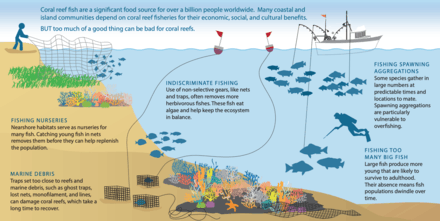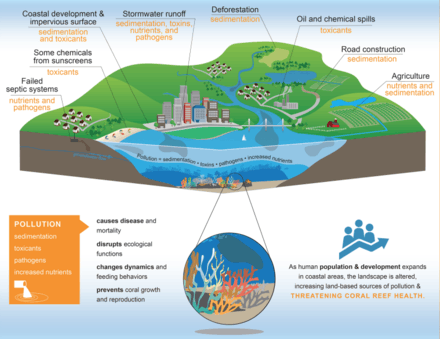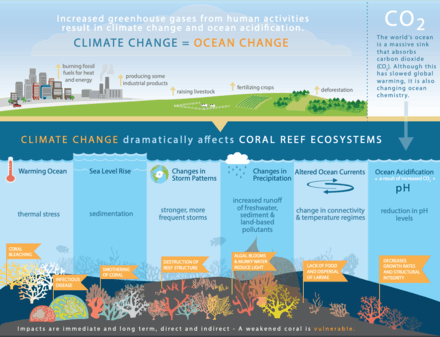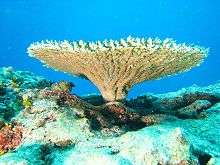Environmental issues with coral reefs
Human impact on coral reefs is significant. Coral reefs are dying around the world.[1] Damaging activities include coral mining, pollution (organic and non-organic), overfishing, blast fishing, the digging of canals and access into islands and bays. Other dangers include disease, destructive fishing practices and warming oceans.[2] Factors that affect coral reefs include the ocean's role as a carbon dioxide sink, atmospheric changes, ultraviolet light, ocean acidification, viruses, impacts of dust storms carrying agents to far-flung reefs, pollutants, algal blooms and others. Reefs are threatened well beyond coastal areas. Climate change, such as warming temperatures, causes coral bleaching, which if severe kills the coral.
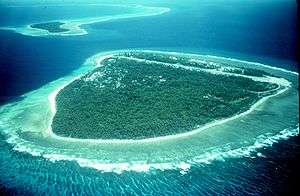
In 2008, a worldwide study estimated that 19% of the existing area of coral reefs has already been lost, and that a further 17% is likely to be lost over the subsequent 10–20 years.[3] Only 46% of the world's reefs could be currently regarded as in good health [3] and about 60% of the world's reefs may be at risk due to destructive, human-related activities. The threat to the health of reefs is particularly strong in Southeast Asia, where 80% of reefs are endangered. By the 2030s, 90% of reefs are expected to be at risk from both human activities and climate change; by 2050, it is predicted that all coral reefs will be in danger.[4][5]
Issues
Competition
In the Caribbean Sea and tropical Pacific ocean, direct contact between coral and common seaweeds causes bleaching and death of coral tissue via allelopathic competition. The lipid-soluble extracts of seaweeds that harmed coral tissues, also produced rapid bleaching. At these sites, bleaching and mortality was limited to areas of direct contact with seaweed or their extracts. The seaweed then expanded to occupy the dead coral's habitat.[6] However, as of 2009, only 4% of coral reefs worldwide had more than 50% algal coverage which means that there are no recent global trend towards algal dominance over coral reefs.[2]
Competitive seaweed and other algae thrive in nutrient-rich waters in the absence of sufficient herbivorous predators. Herbivores include fish such as parrotfish, the urchin Diadema antillarum[7], surgeonfishes, tangs and unicornfishes.[6]
Predation
Overfishing, particularly selective overfishing, can unbalance coral ecosystems by encouraging the excessive growth of coral predators. Predators that eat living coral, such as the crown-of-thorns starfish, are called corallivores. Coral reefs are built from stony coral, which evolved with large amounts of the wax cetyl palmitate in their tissues. Most predators find this wax indigestible.[8] The crown-of-thorns starfish is a large (up to one meter) starfish protected by long, venomous spines. Its enzyme system dissolves the wax in stony corals, and allows the starfish to feed on the living animal. Starfish face predators of their own, such as the giant triton sea snail. However, the giant triton is valued for its shell and has been over fished. As a result, crown-of-thorns starfish populations can periodically grow unchecked, devastating reefs.[9][10][11]
 The overfished giant triton eats the crown-of-thorns starfish.
The overfished giant triton eats the crown-of-thorns starfish. The crown-of-thorns starfish eats coral.
The crown-of-thorns starfish eats coral.
Fishing practices
Although some marine aquarium fish species can reproduce in aquaria (such as Pomacentridae), most (95%) are collected from coral reefs. Intense harvesting, especially in maritime Southeast Asia (including Indonesia and the Philippines), damages the reefs. This is aggravated by destructive fishing practices, such as cyanide and blast fishing. Most (80–90%) aquarium fish from the Philippines are captured with sodium cyanide. This toxic chemical is dissolved in sea water and released into areas where fish shelter. It narcotizes the fish, which are then easily captured. However, most fish collected with cyanide die a few months later from liver damage. Moreover, many non-marketable specimens die in the process.[13] It is estimated that 4,000 or more Filipino fish collectors have used over 1,000,000 kilograms (2,200,000 lb) of cyanide on Philippine reefs alone, about 150,000 kg per year.[14] A major catalyst of cyanide fishing is poverty within fishing communities. In countries like the Philippines that regularly employ cyanide, more than thirty percent of the population lives below the poverty line.[15]
Dynamite fishing is another destructive method for gathering fish. Sticks of dynamite, grenades, or homemade explosives are detonated in the water. This method of fishing kills the fish within the main blast area, along with many unwanted reef animals. The blast also kills the corals in the area, eliminating the reef's structure, destroying habitat for the remaining fish and other animals important for reef health.[14] Muro-ami is the destructive practice of covering reefs with nets and dropping large stones onto the reef to produce a flight response among the fish. The stones break and kill the coral. Muro-ami was generally outlawed in the 1980s.[14]
Fishing gear damages reefs via direct physical contact with the reef structure and substrate. Gill nets, fish traps, and anchors break branching coral and cause coral death through entanglement. When fishermen drop lines by coral reefs, the lines entangle the coral. The fisher cuts the line and abandons it, leaving it attached to the reef. The discarded lines abrade coral polyps and upper tissue layers. Corals are able to recover from small lesions, but larger and recurrent damage complicates recovery.
Bottom dragging gear such as beach seines can damage corals by abrasion and fracturing. A beach seine is a long net about 150 meters (490 ft) with a mesh size of 3 centimeters (1.2 in) and a weighted line to hold the net down while it is dragged across the substrate and is one of the most destructive types of fishing gear on Kenya’s reefs.[14]
Bottom trawling in deep oceans destroys cold-water and deep-sea corals. Historically, industrial fishers avoided coral because their nets would get caught on the reefs. In the 1980s, "rock-hopper" trawls attached large tires and rollers to allow the nets to roll over rough surfaces. Fifty-five percent of Alaskan cold-water coral that was damaged by one pass from a bottom trawl had not recovered a year later. Northeast Atlantic reefs bear scars up to 4 kilometers (2.5 mi) long. In Southern Australia, 90 percent of the surfaces on coral seamounts are now bare rock. Even in the Great Barrier Reef World Heritage Area, seafloor trawling for prawns and scallops is causing localized extinction of some coral species.[14]
"With increased human population and improved storage and transport systems, the scale of human impacts on reefs has grown exponentially. For example, markets for fish and other natural resources have become global, supplying demand for reef resources."[16]
Marine pollution
Reefs in close proximity to human populations are subject to poor water quality from land- and marine-based sources. In 2006 studies suggested that approximately 80 percent of ocean pollution originates from activities on land.[18] Pollution arrives from land via runoff, the wind and "injection" (deliberate introduction, e.g., drainpipes). Runoff brings with it sediment from erosion and land-clearing, nutrients and pesticides from agriculture, wastewater, industrial effluent and miscellaneous material such as petroleum residue and trash that storms wash away. Some pollutants consume oxygen and lead to eutrophication, killing coral and other reef inhabitants.[19]
An increasing fraction of the global population lives in coastal areas. Without appropriate precautions, development (e.g., buildings and paved roads) increases the fraction of rainfall and other water sources that enter the ocean as runoff by decreasing the land's ability to absorb it.[19]
Pollution can introduce pathogens. For example, Aspergillus sydowii has been associated with a disease in sea fans, and Serratia marcescens, has been linked to the coral disease white pox.[19]
Reefs in close proximity to human populations can be faced with local stresses, including poor water quality from land-based sources of pollution.[19] Copper, a common industrial pollutant has been shown to interfere with the life history and development of coral polyps.[20]
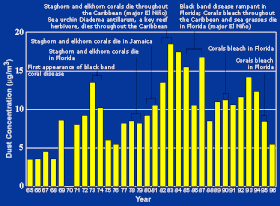
In addition to runoff, wind blows material into the ocean. This material may be local or from other regions. For example, dust from the Sahara moves to the Caribbean and Florida. Dust also blows from the Gobi and Taklamakan deserts across Korea, Japan, and the Northern Pacific to the Hawaiian Islands.[21] Since 1970, dust deposits have grown due to drought periods in Africa. Dust transport to the Caribbean and Florida varies from year to year[22] with greater flux during positive phases of the North Atlantic Oscillation.[23] The USGS links dust events to reduced health of coral reefs across the Caribbean and Florida, primarily since the 1970s.[24] Dust from the 1883 eruption of Krakatoa in Indonesia appeared in the annular bands of the reef-building coral Montastraea annularis from the Florida Reeftract.[25]
Sediment smothers corals and interferes with their ability to feed and reproduce. Pesticides can interfere with coral reproduction and growth.[19] There are studies that present evidence that chemicals in sunscreens contribute to coral bleaching by lowering the resistance of zooxanthellae to viruses,[26][27] though these studies showed significant flaws in methodology and did not attempt to replicate the complex environment found in coral reefs. [28] [29]
Nutrient pollution
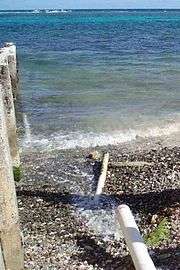
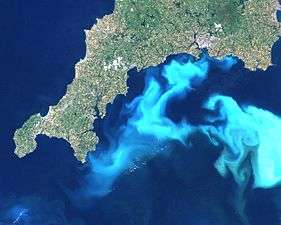
Nutrient pollution, particularly nitrogen and phosphorus can cause eutrophication, upsetting the balance of the reef by enhancing algal growth and crowding out corals. This nutrient–rich water can enable blooms of fleshy algae and phytoplankton to thrive off coasts. These blooms can create hypoxic conditions by using all available oxygen. Biologically available nitrogen (nitrate plus ammonia) needs to be below 1.0 micromole per liter (less than 0.014 parts per million of nitrogen), and biologically available phosphorus (orthophosphate plus dissolved organic phosphorus) needs to be below 0.1 micromole per liter (less than 0.003 parts per million of phosphorus). In addition concentrations of chlorophyll (in the microscopic plants called phytoplankton) needs to be below 0.5 parts per billion.[30] Both plants also obscure sunlight, killing both fish and coral. High nitrate levels are specifically toxic to corals, while phosphates slow down skeletal growth.
Excess nutrients can intensify existing disease, including potentially doubling the spread of Aspergillosis, a fungal infection that kills soft corals such as sea fans, and increasing yellow band disease, a bacterial infection that kills reef-building hard corals by fifty percent.[31]
Air pollution
A study released in April 2013 has shown that air pollution can also stunt the growth of coral reefs; researchers from Australia, Panama and the UK used coral records (between 1880 and 2000) from the western Caribbean to show the threat of factors such as coal-burning coal and volcanic eruptions. The researchers state that the study signifies the first time that the relationship between air pollution and coral reefs has been elucidated, while former chair of the Great Barrier Reef Marine Park Authority Ian McPhail referred to the report as "fascinating" upon the public release of its findings.[32]
Marine debris
Marine debris is any solid object that enters coastal and ocean waters. Debris may arrive directly from a ship or indirectly when washed out to sea via rivers, streams, and storm drains. Human-made items tend to be the most harmful such as plastics (from bags to balloons, hard hats to fishing line), glass, metal, rubber (millions of waste tires), and even entire vessels.[19]
Plastic debris kills several reef species. Derelict (abandoned) fishing nets and other gear—often called "ghost nets" because they still catch fish and other marine life despite being abandoned—can entangle and kill reef organisms and break or damage reefs. Even remote reef systems suffer the effects of marine debris. Reefs in the Northwestern Hawaiian Islands are particularly prone to the accumulation of marine debris because of their central location in the North Pacific Gyre. From 2000 to 2006, NOAA and partners removed over 500 tons of marine debris there.[19]
Cigarette butts too damage aquatic life.[33][34] In order to avoid the cigarette butt litter, some solutions have been proposed, including the possible banning of cigarette filters and the implementing of a deposit system for e-cigarette pods.[35][36]
Dredging
Dredging operations are sometimes completed by cutting a path through a coral reef, directly destroying the reef structure and killing any organisms that live on it.[37] Operations that directly destroy coral are often intended to deepen or otherwise enlarge shipping channels or canals, due to the fact that in many areas, removal of coral requires a permit, making it more cost-effective and simple to avoid coral reefs if possible.
Dredging also releases plumes of suspended sediment, which can settle on coral reefs, damaging them by starving them of food and sunlight. Continued exposure to dredging spoil has been shown to increase rates of diseases such as white syndrome, bleaching and sediment necrosis among others.[38] A study conducted in the Montebello and Barrow Islands showed that the number of coral colonies with signs of poor health more than doubled in transects with high exposure to dredging sediment plumes.[39]
Sunscreen
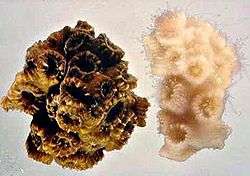
Sunscreen enters the ocean through wastewater systems when it is washed off and from swimmers and divers. Some 14,000 tons of sunscreen ends up in the ocean each year, with 4000 to 6000 tons entering reef areas annually.[40] There is an estimate that 90% of snorkeling and diving tourism is concentrated on 10% of the world's coral reefs, meaning that popular reefs are especially vulnerable to sunscreen exposure[40]. Certain formulations of sunscreen are a serious danger to coral health. The common sunscreen ingredient oxybenzone causes coral bleaching and has an impact on other marine fauna.[41]
In Akumal, Mexico, visitors are warned not to use sunscreen and are kept out of some areas to prevent damage to the coral. In several other tourist destinations, authorities recommend the use of sunscreens prepared with the naturally occurring chemicals titanium dioxide or zinc oxide, or suggest the use of clothing rather than chemicals to screen the skin from the sun.[41][40] In 2019, the city of Miami Beach, Florida has rejected calls for a ban on sunscreen due to lack of evidence [42] In 2020 Palau enacted a ban on sunscreen and skincare products containing 10 chemicals including oxybenzone. The US state of Hawaii enacted a similar ban which comes into effect in 2021.[43]
Climate change
Rising sea levels due to climate change requires coral to grow to stay close enough to the surface to continue photosynthesis. Also, water temperature changes or disease of the coral[45] can induce coral bleaching, as happened during the 1998 and 2004 El Niño years, in which sea surface temperatures rose well above normal, bleaching and killing many reefs. Bleaching may be caused by different triggers, including high sea surface temperature (SST), pollution, or other diseases.[46] SST coupled with high irradiance (light intensity), triggers the loss of zooxanthellae, a symbiotic single cell algae that gives the coral its color and the coral's dinoflagellate pigmentation, which turns the coral white when it is expelled, which can kill the coral. Zooxanthellae provide up to 90% of their hosts' energy supply.[45] Healthy reefs can often recover from bleaching if water temperatures cool. However, recovery may not be possible if CO
2 levels rise to 500 ppm because concentrations of carbonate ions may then be too low.[47][48]
Warming seawater may also encourage an emerging problem: coral disease. Weakened by warm water, coral is much more prone to diseases including black band disease, white band disease and skeletal eroding band. If global temperatures increase by 2 °C during the twenty-first century, coral may not be able to adapt quickly enough.[49]
Warming seawater is also expected to cause migrations in fish populations to compensate for the change. This puts coral reefs and their associated species at risk of invasion and may cause their extinction if they are unable to compete with the invading populations.[50]
A 2010 report by the Institute of Physics predicts that unless the national targets set by the Copenhagen Accord are amended to eliminate loopholes, then by 2100 global temperatures could rise by 4.2 °C and result in an end to coral reefs.[51][52] Even a temperature rise of just 2°C, currently very likely to happen in the next 50 years (so by 2068 A.D.), there would be a more than 99% chance that tropical corals would be eradicated.[53]
Ocean acidification
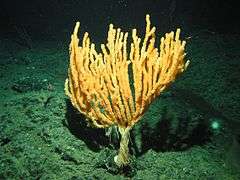
Ocean acidification results from increases in atmospheric carbon dioxide. Oceans absorb around one–third of the increase.[5] The dissolved gas reacts with the water to form carbonic acid, and thus acidifies the ocean. This decreasing pH is another issue for coral reefs.[5]
Ocean surface pH is estimated to have decreased from about 8.25 to 8.14 since the beginning of the industrial era,[54] and a further drop of 0.3–0.4 units is expected.[55] This drop has made it so the amount of hydrogen ions have increased by 30%.[56] Before the industrial age the conditions for calcium carbonate production were typically stable in surface waters since the carbonate ion is at supersaturated concentrations. However, as the ionic concentration falls, carbonate becomes under-saturated, making calcium carbonate structures vulnerable to dissolution.[56] Corals experience reduced calcification or enhanced dissolution when exposed to elevated CO
2.[57] This causes the skeletons of the corals to weaken, or even not be made at all.[56]
Bamboo coral is a deep water coral which produces growth rings similar to trees. The growth rings illustrate growth rate changes as deep sea conditions change, including changes due to ocean acidification. Specimens as old as 4,000 years have given scientists "4,000 years worth of information about what has been going on in the deep ocean interior".[58]
Rising carbon dioxide levels could confuse brain signaling in fish. In 2012, researchers reported on their results after studying the behaviour of baby clown and damselfishes for several years in water with elevated levels of dissolved carbon dioxide, in line with what may exist by the end of the century. They found that the higher carbon dioxide disrupted a key brain receptor in the fish, interfering with neurotransmitter functions. The damaged central nervous systems affected fish behaviour and diminishing their sensory capacity to a point "likely to impair their chances of survival". The fishes were less able to locate reefs by smell or "detect the warning smell of a predator fish". Nor could they hear the sounds made by other reef fish, compromising their ability to locate safe reefs and avoid dangerous ones. They also lost their usual tendencies to turn to the left or right, damaging their ability to school with other fish.[59][60][61]
Disease
Disease is a serious threat to many coral species. The diseases of coral may consist of bacterial, viral, fungal, or parasitic infections. Due to stressors like climate change and pollution, coral can become more vulnerable to diseases. Some examples of coral disease are Vibrio, white syndrome, white band, rapid wasting disease, and many more.[62] These diseases have different effects on the corals, ranging from damaging and killing individual corals to wiping out entire reefs.[62]
In the Caribbean, white band disease is one of the primary causes for the death of over eighty percent of Staghorn and Elkhorn coral (Reef Resilience). It is a disease that can destroy miles of coral reef fast.
A disease such as white plague can spread over a coral colony by a half an inch a day. By the time the disease has fully taken over the colony, it leaves behind a dead skeleton. Dead standing coral structures are what most people see after disease has taken over a reef.
Recently, the Florida Reef Tract in the United States has been plagued by a stony coral tissue loss disease. The disease was first identified in 2014 and as of 2018 has been reported in every part of the reef except the lower Florida Keys and the Dry Tortugas. The cause of the disease is unknown but is thought to be caused by bacteria and be transmitted through direct contact and water circulation. This disease event is unique due to its large geographic range, extended duration, rapid progression, high rates of mortality and the number of species affected.[63]
Recreational diving
During the 20th century recreational scuba diving was considered to have generally low environmental impact, and was consequently one of the activities permitted in most marine protected areas. Since the 1970s diving has changed from an elite activity to a more accessible recreation, marketed to a very wide demographic. To some extent better equipment has been substituted for more rigorous training, and the reduction in perceived risk has shortened minimum training requirements by several training agencies. Training has concentrated on an acceptable risk to the diver, and paid less attention to the environment. The increase in the popularity of diving and in tourist access to sensitive ecological systems has led to the recognition that the activity can have significant environmental consequences.[64]
Scuba diving has grown in popularity during the 21st century, as is shown by the number of certifications issued worldwide, which has increased to about 23 million by 2016 at about one million per year.[65] Scuba diving tourism is a growth industry, and it is necessary to consider environmental sustainability, as the expanding impact of divers can adversely affect the marine environment in several ways, and the impact also depends on the specific environment. Tropical coral reefs are more easily damaged by poor diving skills than some temperate reefs, where the environment is more robust due to rougher sea conditions and fewer fragile, slow-growing organisms. The same pleasant sea conditions that allow development of relatively delicate and highly diverse ecologies also attract the greatest number of tourists, including divers who dive infrequently, exclusively on vacation and never fully develop the skills to dive in an environmentally friendly way.[66] Low impact diving training has been shown to be effective in reducing diver contact to more sustainable levels.[64]
Other issues

Within the last 20 years, once-prolific seagrass meadows and mangrove forests, which absorb massive amounts of nutrients and sediment, have been destroyed. Both the loss of wetlands, mangrove habitats and seagrass meadows affect the water quality of inshore reefs.[67]
Coral mining is another threat. Both small scale harvesting by villagers and industrial scale mining by companies are serious threats. Mining is usually done to produce construction material which is valued as much as 50% cheaper than other rocks, such as from quarries.[68] The rocks are ground and mixed with other materials, like cement to make concrete. Ancient coral used for construction is known as coral rag. Building directly on the reef also takes its toll, altering water circulation and the tides which bring the nutrients to the reef. The pressing reason for building on reefs is simply lack of space.
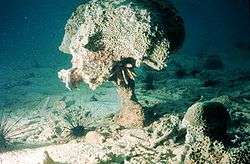
Boats and ships require access points into bays and islands to load and unload cargo and people. For this, parts of reefs are often chopped away to clear a path. Negative consequences can include altered water circulation and altered tidal patterns which can disrupt the reef's nutrient supply; sometimes destroying a great part of the reef. Fishing vessels and other large boats occasionally run aground on a reef. Two types of damage can result. Collision damage occurs when a coral reef is crushed and split by a vessel's hull into multiple fragments. Scarring occurs when boat propellers tear off the live coral and expose the skeleton. The physical damage can be noticed as striations. Mooring causes damage which can be reduced by using mooring buoys. Buoys can attach to the seafloor using concrete blocks as weights or by penetrating the seafloor, which further reduces damage.[70] Also, reef docks can be used to move over goods from large, seagoing vessels to small, flat-bottomed vessels.
Coral in Taiwan is being threatened by the influx of human population growth. Since 2007, several local environmental groups conducted research and found that much of the coral populations are being affected by untreated sewage, an influx of tourists taking corals for souvenirs, without fully understanding the destructive impact on the coral's ecological system. Researchers reported to the Taiwanese government that many coral populations have turned black in the southeast coast of Taiwan. Potentially, this could lead to loss of food supply, medicinal sources and tourism due to the breakdown of the food chain.[71]
Threatened species
The global standard for recording threatened marine species is the IUCN Red List of Threatened Species.[72] This list is the foundation for marine conservation priorities worldwide. A species is listed in the threatened category if it is considered to be critically endangered, endangered, or vulnerable. Other categories are near threatened and data deficient. By 2008, the IUCN had assessed all 845 known reef-building corals species, marking 27% as Threatened 20% as near threatened and 17% as data deficient.[73]
The coral triangle (Indo-Malay-Philippine archipelago) region has the highest number of reef-building coral species in threatened category as well as the highest coral species diversity. The loss of coral reef ecosystems will have devastating effects on many marine species, as well as on people that depend on reef resources for their livelihoods.[73]
Issues by region
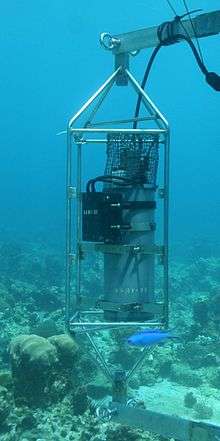
2 sensor (SAMI-CO2), attached to a Coral Reef Early Warning System station in Discovery Bay, Jamaica, utilized in conducting ocean acidification studies near coral reef areas
Australia
The Great Barrier Reef is the world's largest coral reef system.[74][75][76][77] The reef is located in the Coral Sea and a large part of the reef is protected by the Great Barrier Reef Marine Park. Particular environmental pressures include surface runoff, salinity fluctuations, climate change, cyclic crown-of-thorns outbreaks, overfishing, and spills or improper ballast discharge. According to the 2014 report of the Government of Australia's Great Barrier Reef Marine Park Authority (GBRMPA), climate change is the most significant environmental threat to the Great Barrier Reef.[78] As of 2018, 50% of the coral on the Great Barrier Reef has been lost.[79]
Southeast Asia
Southeast Asian coral reefs are at risk from damaging fishing practices (such as cyanide and blast fishing), overfishing, sedimentation, pollution and bleaching. Activities including education, regulation and the establishment of marine protected areas help protect these reefs.
Indonesia
Indonesia is home to one-third of the world's coral reefs, with coral that covers nearly 85,000 square kilometres (33,000 sq mi) and is home to one-quarter of its fish species. Indonesia's coral reefs are located in the heart of the Coral Triangle and have fallen victim to destructive fishing, tourism and bleaching. Data from LIPI in 1998 found that only 7 percent is in excellent condition, 24 percent is in good condition and approximately 69 percent is in poor-to-fair condition. According to one source, Indonesia will lose 70 percent of its coral reef by 2050 if restoration action does not occur.[80]
Philippines
In 2007, Reef Check, the world's largest reef conservation organization, stated that only 5% of Philippines 27,000 square kilometres (10,000 sq mi) of coral reef are in "excellent condition": Tubbataha Reef, Marine Park in Palawan, Apo Island in Negros Oriental, Apo Reef in Puerto Galera, Mindoro, and Verde Island Passage off Batangas. Philippine coral reefs is Asia's second largest.[81]
Taiwan
Coral reefs in Taiwan are being threatened by human population growth. Many corals are affected by untreated sewage and souvenir-hunting tourists, not knowing that this practice destroys habitat and causes disease. Many corals have turned black from disease off Taiwan's southeast coast.[82]
Caribbean
Coral disease was first recognized as a threat to Caribbean reefs in 1972 when black band disease was discovered. Since then diseases have been occurring with higher frequency.[83]
It has been estimated that 50% of the Caribbean sea coral cover has disappeared since the 1960s. According to a United Nations Environment Program report, the Caribbean coral reefs might face extirpation in next 20 years due to population expansion along the coast lines, overfishing, the pollution of coastal areas, global warming, and invasive species.[84]
In 2005, the Caribbean lost about 50% of its reef in one year due to coral bleaching. The warm water from Puerto Rico and the Virgin Islands travelled south to cause this coral bleaching.[85]
Jamaica
Jamaica is the third largest Caribbean island. The Caribbean's coral reefs will cease to exist in 20 years if a conservation effort is not made.[86] In 2005, 34 percent of Jamaica's coral reefs were bleached due to rising sea temperatures.[87] Jamaica's coral reefs are also threatened by overfishing, pollution, natural disasters, and reef mining.[88] In 2009, researchers concluded that many of the corals are recovering very slowly.[89]
United States
Southeastern Florida’s reef track is 300 miles long.[90] Florida's coral reefs are currently undergoing an unprecedented stony coral tissue loss disease. The disease covers a large geographic range and affects many species of coral.[63]
In January 2019, science divers confirmed that the outbreak of stony coral tissue that extends south and west of Key West. In December 2018, Disease was spotted at Maryland Shoals, near the Saddlebunch Keys. By mid January 5 more sites between American Shoal and Eastern Dry Rocks were confirmed diseased.[91]
Puerto Rico is home to over 5,000 square kilometers of shallow coral reef ecosystems. Puerto Rico’s coral reefs and associated ecosystems have an average economic value of nearly $1.1 billion per year.[92]
The U.S. Virgin Islands’ coral reefs and associated ecosystems have an average economic value of $187 million per year.[93]
Pacific
United States
Hawaii's coral reefs (e.g. French Frigate Shoals) are a major factor in Hawaii's $800 million a year marine tourism and are being affected negatively by coral bleaching and increased sea surface temperatures, which in turn leads to coral reef diseases. The first large-scale coral bleaching occurred in 1996 and in 2004 it was found that the sea surface temperatures had been steadily increasing and if this pattern continues, bleaching events will occur more frequently and severely.[94]
References
- "Coral reefs around the world". Guardian.com. 2 September 2009. Retrieved 12 June 2010.
- "In The Turf War Against Seaweed, Coral Reefs More Resilient Than Expected". Science Daily. June 3, 2009. Retrieved 1 February 2011.
- Wilkinson, Clive (2008) Status of Coral Reefs of the World: Executive Summary. Global Coral Reef Monitoring Network.
- "Reefs at Risk Revisited" (PDF). World Resources Institute. February 2011. Retrieved 16 March 2012.
- Kleypas, Joan A.; Feely, Richard A.; Fabry, Victoria J.; Langdon, Chris; Sabine, Christopher L.; Robbins, Lisa L. (June 2006). "Impacts of Ocean Acidification on Coral Reefs and Other Marine Calcifiers: A Guide for Future Research" (PDF). Archived from the original (PDF) on 20 July 2011. Retrieved 1 February 2011.
- Rasher, Douglas B.; Hay, Mark E. (May 25, 2010). "Chemically rich seaweeds poison corals when not controlled by herbivores". Proceedings of the National Academy of Sciences of the United States of America. 107 (21): 9683–9688. Bibcode:2010PNAS..107.9683R. doi:10.1073/pnas.0912095107. PMC 2906836. PMID 20457927.
- RAAK PRO Diadema-project
- Benson AA and Muscatine L (1974) Wax in Coral Mucus: Energy Transfer From Corals to Reef Fishes Limnology and Oceanography, 19 (5) 810–814. Download Archived 2011-07-20 at the Wayback Machine
- Predators and Prey PBS.org. Retrieved 11 December 2009.
- "CRC Reef Research Centre Technical Report No. 32 — Crown-of-thorns starfish(Acanthaster planci) in the central Great Barrier Reef region. Results of fine-scale surveys conducted in 1999–2000". Archived from the original on 29 August 2007. Retrieved 7 June 2007.
- CRC Reef Research Centre. "Crown-of-thorns starfish on the Great Barrier Reef" (PDF). Archived from the original (PDF) on 26 August 2006. Retrieved 28 August 2006. (PDF)
- How does overfishing threaten coral reefs? NOAA: National Ocean Service. Retrieved 9 February 2020. Updated: 25 June 2018.
- Lecchini, David; Polti, Sandrine; Nakamura, Yohei; Mosconi, Pascal; Tsuchiya, Makoto; Remoissenet, Georges; Planes, Serge (2006). "David LECCHINI, Sandrine POLTI, Yohei NAKAMURA, Pascal MOSCONI, Makoto TSUCHIYA, Georges REMOISSENET, Serge PLANES (2006) "New perspectives on aquarium fish trade" Fisheries Science 72 (1), 40–47". Fisheries Science. 72: 40–47. doi:10.1111/j.1444-2906.2006.01114.x.
- McClellan, Kate; Bruno, John (2008). "Coral degradation through destructive fishing practices". Encyclopedia of Earth. Retrieved 25 October 2008.
- "CIA—The World Factbook—Philippines". CIA. Archived from the original on 11 January 2010. Retrieved 1 February 2011.
- Hughes; et al. (15 August 2003). "Climate Change, Human Impacts, and the Resilience of Coral Reefs". Science. 301 (5635): 929–933. Bibcode:2003Sci...301..929H. doi:10.1126/science.1085046. PMID 12920289. S2CID 1521635.
- How does land-based pollution threaten coral reefs? NOAA: National Ocean Service. Accessed 9 February 2020. Update 18 April 2019.
- "UNEP in 2006" (PDF). Retrieved 18 August 2012.
- "How Pollution Affects Coral Reefs". NOAA. Retrieved 18 August 2012.
- Emma Young (February 18, 2003). "Copper decimates coral reef spawning". New Scientist. Retrieved 26 August 2006.
- Duce, R.A.; Unni, C.K.; Ray, B.J.; Prospero, J.M.; Merrill, J.T. (1980). "Long-range atmospheric transport of soil dust from Asia to the tropical North Pacific: Temporal variability". Science. 209 (4464): 1522–1524. Bibcode:1980Sci...209.1522D. doi:10.1126/science.209.4464.1522. PMID 17745962. S2CID 30337924.
- Usinfo.state.gov.Study Says African Dust Affects Climate in U.S., Caribbean. Archived 2007-06-20 at the Wayback Machine Retrieved on 10 June 2007.
- Prospero J.M.; Nees R.T. (1986). "Impact of the North African drought and El Niño on mineral dust in the Barbados trade winds". Nature. 320 (6064): 735–738. Bibcode:1986Natur.320..735P. doi:10.1038/320735a0.
- United States Geological Survey. Coral Mortality and African Dust. Retrieved on 10 June 2007.
- Merman, E.A. 2001. Atmospheric inputs to the tropical ocean—unlocking the record in annually banded corals. Master's thesis. University of South Florida, St. Petersburg.
- Danovaro, Roberto; Bongiorni, Lucia; Corinaldesi, Cinzia; Giovannelli, Donato; Damiani, Elisabetta; Astolfi, Paola; Greci, Lucedio; Pusceddu, Antonio (2008). "Sunscreens Cause Coral Bleaching by Promoting Viral Infections". Environmental Health Perspectives. 116 (4): 441–447. doi:10.1289/ehp.10966. PMC 2291018. PMID 18414624.
- Downs, C. A.; Kramarsky-Winter, E.; Fauth, J. E.; Segal, R.; Bronstein, O.; Jeger, R.; Loya, Y. (2014). "Toxicological effects of the sunscreen UV filter, benzophenone-2, on planulae and in vitro cells of the coral, Stylophora pistillata". Ecotoxicology. 23 (2): 175–191. doi:10.1007/s10646-013-1161-y. PMID 24352829.
- Ogles, Jacob. "Scientific consensus mounts in favor of sunscreen". Florida Politics. Peter Schorsch.
- "PubPeer: Toxicopathological Effects of the Sunscreen UV Filter, Oxybenzone (Benzophenone-3), on Coral Planulae and Cultured Primary Cells and Its Environmental Contamination in Hawaii and the U.S. Virgin Islands". PubPeer.
- "Eutrofication and water quality". Global Coral Reef Alliance. Archived from the original on 9 October 2010. Retrieved 1 February 2011.
- Rachel Nowak (11 January 2004). "Sewage nutrients fuel coral disease". New Scientist. Retrieved 10 August 2006.
- Liz Minchin (8 April 2013). "Air pollution casts a cloud over coral reef growth". The Conversation. The Conversation Media Group. Retrieved 9 April 2013.
- What You Can Do to Help Protect Coral Reefs
- The Environmental Impact of Cigarette Butt Waste: Just the Facts
- Cigarette butts are toxic plastic pollution. Should they be banned?
- The Cigarette Butt Pollution Project
- "Scientists race to save coral doomed by Government Cut dredging - Environment - MiamiHerald.com". miamiherald.com. Archived from the original on 15 July 2014. Retrieved 21 August 2014.
- "Coral reefs face heightened risk of fatal disease from dredging, says research | Environment | theguardian.com". theguardian.com. Retrieved 21 August 2014.
- Pollock, F. Joseph; Lamb, Joleah B.; Field, Stuart N.; Heron, Scott F.; Schaffelke, Britta; Shedrawi, George; Bourne, David G.; Willis, Bette L. (2014). "PLOS ONE: Sediment and Turbidity Associated with Offshore Dredging Increase Coral Disease Prevalence on Nearby Reefs". PLOS ONE. 9 (7): e102498. doi:10.1371/journal.pone.0102498. PMC 4100925. PMID 25029525.
- "National Park Service - Protect Yourself, Protect the Reef!" (PDF). Retrieved 2019-01-15.
- Wagner, Laura (October 20, 2015). "Chemicals In Sunscreen Are Harming Coral Reefs, Says New Study". NPR.org. Retrieved 2017-04-09.
- Wang, Francis. "Miami Beach Commissioners Vote Not To Ban Sunscreen Ingredients Experts Say Harm Coral Reefs". CBS Miami. CBS.
- "Palau is first country to ban 'reef toxic' sun cream". BBC.co.uk. BBC. Retrieved 2020-01-01.
- How does climate change affect coral reefs? NOAA: National Ocean Service. Accessed 9 February 2020. Update 13 November 2019.
- Ocean. DK. 2006. p. 263.
- Ocean. DK. 2006. pp. 152–155.
- Leahy, Stephen (2007). "Environment: Between a Reef and a Hard Place". NoticiasFinancieras. Archived from the original on 2009-10-08.
- Hoegh-Guldberg 1999
- Glynn, P.W. (March 1993). "Coral Reef Bleaching: Ecological Perspectives" Earth and Environmental Science". Coral Reefs. 12 (1): 1–17. Bibcode:1993CorRe..12....1G. doi:10.1007/BF00303779.
- Airamé, S. (June 2009). "Climate Change, Coral Reef Ecosystems, and Management Options for Marine Protected Areas". Environmental Management. 44 (6): 1069–1088. Bibcode:2009EnMan..44.1069K. doi:10.1007/s00267-009-9346-0. PMC 2791481. PMID 19636605.
- Climate Accord loopholes could spell 4.2°C rise in temperature and end of coral reefs by 2100 Institute of Physics, Press release, 29 September 2010.
- Rogelj J, Chen C, Nabel J, Macey K, Hare W, Schaeffer M, Markmann K, Höhne N, Andersen KK, et al. (2010). "Analysis of the Copenhagen Accord pledges and its global climatic impacts—a snapshot of dissonant ambitions". Environmental Research Letters. 5 (3): 3. Bibcode:2010ERL.....5c4013R. doi:10.1088/1748-9326/5/3/034013.
- Next generation ‘may never see the glory of coral reefs’
- Jacobson, M. Z. (2005). "Studying ocean acidification with conservative, stable numerical schemes for nonequilibrium air-ocean exchange and ocean equilibrium chemistry" (PDF). Journal of Geophysical Research: Atmospheres. 110: D07302. Bibcode:2005JGRD..11007302J. doi:10.1029/2004JD005220. Archived from the original (PDF) on 28 June 2011. Retrieved 1 February 2011.
- Orr, J. C.; et al. (2005). "Anthropogenic ocean acidification over the twenty-first century and its impact on calcifying organisms" (PDF). Nature. 437 (7059): 681–686. Bibcode:2005Natur.437..681O. doi:10.1038/nature04095. PMID 16193043. Archived from the original (PDF) on 2008-06-25.
- "Coral Reefs and Coral". Gale Virtual Reference Library. 2009. Retrieved 2017-03-13.
- Gattuso, J.-P.; Frankignoulle, M.; Bourge, I.; Romaine, S. & Buddemeier, R. W. (1998). "Effect of calcium carbonate saturation of seawater on coral calcification". Glob. Planet. Change. 18 (1–2): 37–46. Bibcode:1998GPC....18...37G. doi:10.1016/S0921-8181(98)00035-6.
- "National Oceanic and Atmospheric Administration – New Deep-Sea Coral Discovered on NOAA-Supported Mission". www.noaanews.noaa.gov. Retrieved 11 May 2009.
- Carbon dioxide affecting fish brains: study ABC, 16 January 2012.
- Rising carbon dioxide confuses brain signaling in fish Science News Online, 16 January 2012.
- Nilsson GE, Dixson DL, Domenici P, McCormick MI, Sørensen C, Watson S, Munday PL (2012). "Near-future carbon dioxide levels alter fish behaviour by interfering with neurotransmitter function Letter". Nature Climate Change. 2 (3): 1. Bibcode:2012NatCC...2..201N. doi:10.1038/nclimate1352.
- Bruckner, Andrew and Robin (1998). "Emerging Infections on the Reefs". EBSCO. Retrieved 2017-03-13.
- "Florida Reef Tract Coral Disease Outbreak". NOAA Florida Keys National Marine Sanctuary. Retrieved 2019-01-14.
- Hammerton, Zan (2014). SCUBA-diver impacts and management strategies for subtropical marine protected areas (Thesis). Southern Cross University.
- Lucrezi, Serena (18 January 2016). "How scuba diving is warding off threats to its future". The Conversation. Retrieved 5 September 2019.
- Dimmock, Kay; Cummins, Terry; Musa, Ghazali (2013). "Chapter 10: The business of Scuba diving". In Musa, Ghazali; Dimmock, Kay (eds.). Scuba Diving Tourism. Routledge. pp. 161–173.
- Australian Government Productivity Commission (2003). "Industries, Land Use and Water Quality in the Great Barrier Reef Catchment – Key Points". Archived from the original on 6 September 2006. Retrieved 29 May 2006.
- The Greenpeace Book of Coral Reefs
- Ryan Holl (17 April 2003). "Bioerosion: an essential, and often overlooked, aspect of reef ecology". Iowa State University. Archived from the original on 2 September 2003. Retrieved 2 November 2006.
- "Department of Commerce Awards Bronze Medal to Florida Biologist John Halas". Archived from the original on 2010-07-22. Retrieved 2010-06-12.
- Jennings, R. (Feb. 6, 2009). Taiwan coral reefs "turn black" with disease. From Reuters: https://www.reuters.com/article/idUSTRE5151HL20090206
- "The 2008 IUCN Red List of Threatened Species". Archived from the original on July 6, 2009.
- IUCN: Status of the world's marine species
- UNEP World Conservation Monitoring Centre (1980). "Protected Areas and World Heritage – Great Barrier Reef World Heritage Area". Department of the Environment and Heritage. Archived from the original on 15 January 2006. Retrieved 10 June 2006.
- "Great Barrier Reef World Heritage Values". Archived from the original on 6 October 2006. Retrieved 10 November 2006.
- Fodor's. "Great Barrier Reef Travel Guide". Retrieved 8 August 2006.
- Department of the Environment and Heritage. "Review of the Great Barrier Reef Marine Park Act 1975". Archived from the original on 18 October 2006. Retrieved 2 November 2006.
- GBRMPA (2014). "GBRMPA Outlook Report 2014". Australian Government Great Barrier Reef Marine Park Authority. Australian Government. Archived from the original (PDF) on 13 August 2014. Retrieved 15 August 2014.
- James, Lauren E. (August 2018). "Half of the Great Barrier Reef is Dead". National Geographic. Retrieved February 1, 2019.
- Ditulis oleh susan (30 November 2010). "Mengenali Sumberdaya Pesisir dan Laut". Pelajar Progressif (in Malay). Google, Inc. Retrieved 22 April 2013.
- "ABS-CBN Interactive". Archived from the original on 2007-07-09.
- Jennings, R. (Feb 6, 2009). "Taiwan coral reefs "turn black" with disease". Reuters.
- "Information about Coral Disease". NOAA Coral Disease & Health Consortium. Retrieved 15 January 2019.
- "Caribbean coral reefs may disappear within 20 years: Report". IANS. news.biharprabha.com. Retrieved 3 July 2014.
- US Department of Commerce, National Oceanic and Atmospheric Administration. "What is coral bleaching?". oceanservice.noaa.gov. Retrieved 5 March 2019.
- Aldred, Jessica (2014-07-02). "Caribbean coral reefs 'will be lost within 20 years' without protection". The Guardian. ISSN 0261-3077. Retrieved 2017-08-06.
- "Coral Reefs in Jamaica". Retrieved 2017-08-06.
- Hughes, Terence P. (1994). "Catastrophes, Phase Shifts, and Large-Scale Degradation of a Caribbean Coral Reef". Science. 265 (5178): 1547–1551. Bibcode:1994Sci...265.1547H. doi:10.1126/science.265.5178.1547. JSTOR 2884556. PMID 17801530. S2CID 43204708.
- Crabbe, M.J.C. (2009). "Scleractinian coral population size structures and growth rates indicate coral resilience on the fringing reefs of North Jamaica" (PDF). Marine Environmental Research. 67 (4–5): 189–198. doi:10.1016/j.marenvres.2009.01.003. PMID 19269026.
- "Florida". NOAA Office for Coastal Management. Retrieved 16 January 2019.
- NOAA. "Florida Reef Tract Coral Disease Outbreak | Florida Keys National Marine Sanctuary". floridakeys.noaa.gov.
- "Puerto Rico". NOAA Office for Coastal Management. Retrieved 16 January 2019.
- "U.S. Virgin Islands". NOAA Office for Coastal Management. Retrieved 16 January 2019.
- Aeby, Greta. "Coral Reefs : Climate Change and Marine Disease". dlnr.hawaii.gov. Retrieved 5 March 2019.
- "Reef Resilience: Coral Reef Resilience to Crown of Thorns Starfish and Coral Bleaching". livingoceansfoundation.org. Khaled bin Sultan Living Oceans Foundation. 16 November 2016.
See also
Further reading
- Barber, Charles V. and Vaughan R. Pratt. 1998. Poison and Profit: Cyanide Fishing in the Indo-Pacific. Environment, Heldref Publications.
- Martin, Glen. 2002. "The depths of destruction Dynamite fishing ravages Philippines' precious coral reefs". San Francisco Chronicle, 30 May 2002
External links
- Hoegh-Guldberg, Ove (1999). "Climate Change: Coral Reefs on the Edge". Global Change Institute, University of Queensland. Archived from the original on 2010-06-14.CS1 maint: ref=harv (link)
- NOAA Report: The State of Coral Reef Ecosystems of the United States and Pacific Freely Associated States: 2008
- A special report on the plight of the planet's coral reefs—and how you can help—from Mother Jones magazine
